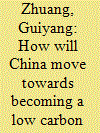| Srl | Item |
| 1 |
ID:
105789


|
|
|
|
|
| Publication |
2011.
|
| Summary/Abstract |
A multi-region, multi-sector dynamic computable general equilibrium model is applied to explore the economic and welfare effects of the pledges submitted by developed countries (Annex I countries) and major developing (non-Annex I) countries for 2020 under the Copenhagen Accord. In addition to analyzing scenarios reflecting the upper and lower bounds of the Copenhagen Pledges, one additional policy scenario where Annex I countries as a group reduce CO2-emissions by 30% in 2020 compared to 1990 levels, and where major non-Annex I countries reduce CO2 emissions 15% below baseline, is also analyzed. Economic effects are measured as changes in GDP compared to baseline and welfare effects are measured via the equivalent variation. Assuming that countries with emission targets may trade certificates, average reductions in GDP for countries with targets range between 0.1% and 0.7% in 2020 for the policy scenarios. While the GDP losses are larger for major non-Annex I countries with emission targets compared to Annex I countries, this is not the case for the changes in welfare. With the exception of Mexico, the welfare losses for the major non-Annex I regions, as a percentage of projected GDP in 2020, are lower than for the large Annex I countries.
|
|
|
|
|
|
|
|
|
|
|
|
|
|
|
|
| 2 |
ID:
081899


|
|
|
|
|
| Publication |
2008.
|
| Summary/Abstract |
China is facing increasing pressure from the international community to curb its greenhouse emissions. The next 15-20 years are important for China's social and economic development, but this is also a key period for controlling global greenhouse gas emissions. In considering the development path of China's economy, policy-makers are confronted by the issue of global climate change. Reducing carbon emissions is now a worldwide task. For China, opportunities and challenges coexist. Post-Kyoto climate regime must provide incentives for China's transition to becoming a low carbon economy based on the principle of common but differentiated responsibilities
|
|
|
|
|
|
|
|
|
|
|
|
|
|
|
|